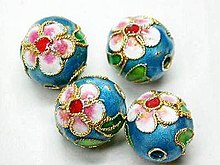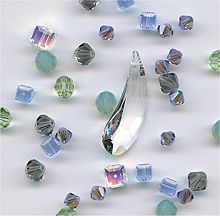Bead: Difference between revisions
m Reverted edits by 150.101.121.120 (talk) to last version by 66.27.137.83 |
|||
| Line 49: | Line 49: | ||
===Fire-polished beads=== |
===Fire-polished beads=== |
||
Fire polished beads from the Czech Republic are a faceted glass bead. Czech fire polish beads are made in an area called Jablonec nad Nisou. Production of glass beads in the area dates back to the 14th century and this area is well known for the manufacture of high quality glass beads. They are available in many different shapes, colors, sizes, finishes and with many different coatings also available. They offer a cost effective yet superior quality crystal suitable for many different types of beading projects. Czech fire polished beads have become so popular in recent years, primarily because they are the highest quality manufactured faceted bead available. This has helped make them one of the most favored glass beads by jewelry makers and beadworkers alike. |
|||
shiny beads *sparkle* |
|||
===Furnace glass beads=== |
===Furnace glass beads=== |
||
Revision as of 01:43, 22 October 2007

A bead is a small, decorative object that is pierced for threading or stringing. As an alternative to piercing, plastic beads may be Moulded Onto a Thread during manufacturing; these MOT beads are often used for the throw necklaces worn at Mardi Gras. Beads range in size from under a millimeter to over a centimeter or sometimes several centimeters in diameter. Glass, plastic, and stone are probably the most common materials, but beads are also made from bone, horn, ivory, metal, shell, pearl, coral, gemstones, polymer clay, metal clay, resin, synthetic minerals, wood, ceramic, fiber, paper, and seeds. A pair of beads made from Nassarius shells that are approximately 100,000 years old are thought to be the first known examples of jewelery.[1][2]
Beadwork is the craft of making things with beads. Beads can be woven together with specialized thread, strung onto thread or wire, or adhered to a surface (e.g. fabric, clay).
Types of beads


Types of decorative beads include:
- Chevron beads
- Cloisonné beads
- Dichroic beads
- Ethnic beads
- Faux natural beads
- Fire-polished beads
- Furnace glass beads
- Fused glass beads
- Lampwork beads
- Lead crystal beads
- Millefiori beads
- Pressed glass beads
- Seed beads
- Shell beads
- Trade beads or Slave beads
Chevron beads
Chevron Beads are special glass beads, originally made for the slave trade in Africa by glassmakers in Italy. They are composed of many consecutive layers of colored glass. The initial core is formed in a star-shaped mold, and can have anywhere between five and fifteen points. The next layer of glass conforms to that star shape. Several layers of glass can be applied, either star-shaped or smooth. After all layers have been applied, the glass is drawn out to the desired thickness and when cooled, cut into short segments showing the resulting star pattern at their ends. The ends can be ground to display the chevron pattern. Chevron beads are traditionally composed of red, blue, and white layers, but modern chevrons can be found in any color combination.
Dichroic glass beads
Increasingly, dichroic glass is being used to produce high-end art beads. Dichroic glass has a thin film of metal fused to the surface of the glass, resulting in a surface that has a metallic sheen that changes between two colors when viewed at different angles. Beads can be pressed, or made with traditional lampworking techniques. The metal coating used was origanllay developed by NASA for the space program.
Ethnic beads

Other beads considered trade beads are those made in West Africa, by and for Africans, such as Mauritanian Kiffa beads, and Ghanaian and Nigerian powder glass beads . Other ethnic beads include Tibetan Dzi beads and African-made brass beads. Rudraksha beads are seeds that are customary in India for making Buddhist and Hindu rosaries (malas). Magatama are traditional Japanese beads, and cinnabar was often used for beads in China.
Faux natural beads
Often beads are made to look like a more expensive original material, especially in the case of fake pearls and simulated rocks, minerals, and gemstones. Precious metals and ivory are also imitated.
Tagua nuts from South American are used as an ivory substitute since the natural ivory trade has been restricted worldwide.

Fire-polished beads
Fire polished beads from the Czech Republic are a faceted glass bead. Czech fire polish beads are made in an area called Jablonec nad Nisou. Production of glass beads in the area dates back to the 14th century and this area is well known for the manufacture of high quality glass beads. They are available in many different shapes, colors, sizes, finishes and with many different coatings also available. They offer a cost effective yet superior quality crystal suitable for many different types of beading projects. Czech fire polished beads have become so popular in recent years, primarily because they are the highest quality manufactured faceted bead available. This has helped make them one of the most favored glass beads by jewelry makers and beadworkers alike.
Furnace glass beads

Furnace glass beads are a special type of art bead. They are made using traditional glassworking techniques from Italy that are more often used to make art glass objects. The manufacture of these beads requires a large glass furnace and annealing kiln.
Furnace glass beads, also called cane glass beads, are sliced from long glass rods, often decorated with stripes and other color, also known as canes.
Lampwork beads
Lampwork beads are made by using a torch to heat a rod of glass and spinning the resulting thread around a metal rod covered in bead release. When the base bead has been formed, other colors of glass can be added to the surface to create many designs.

Swarovski along with Preciosa crystal beads are also prized by jewelers and hobbyists. They are a content high-lead crystal although today production of lead-free crystal is common. Crystals have an incredible sparkle and clarity, and are often multi-faceted to resemble gemstones. Styles and colors go in and out of production, so vintage cuts and colors are often prized with a similarly associated price tag. Swarovski along with Preciosa bicones are the most popular crystal beads in sizes 4 mm and 6 mm. Crystal and Crystal AB are the most common colors. Other Czech companies such as PAS Jablonec make similar styles of crystal beads. Swarovski crystals, Preciosa crystals and similar leaded crystal beads are also known as machine cut crystal. Machine cut crystals are beads, chatons and other crystal items cut by hi-tech precise machines. Thanks to this state of the art machine cut processing the crystal items achieve outstanding geometry and excellent optical parameters. Many lead crystal beads are enhanced with surface coatings. Aurora Borealis, or AB, is a surface coating on the lead crystal bead that diffuses light into a rainbow. Other common surface coatings are vitrail, moonlight, dorado, satin, star shine, heliotrope.
Millefiori beads
The millefiori technique involves the production of glass canes or rods, known as murrine, with multicolored patterns which are viewable only from the cut ends of the cane. Millefiori beads are made of plain wound glass bead cores and thin slices of cut cane (murrine) which are being pressed into the bead surface, forming mosaic-like patterns, while the glass is still hot. Another name for Millefiori bead is mosaic bead.
Pressed glass beads

Pressed glass beads are formed by pressing the hot glass into mold to give the bead its shape. Often pressed glass beads are made using machines that stamp the shape from the molten glass. The shapes can have holes punched in virtually any direction.
Seed beads
Seed beads are uniformly shaped spheroidal or tube shaped beads ranging in size from under a millimetre to several millimetres. "Seed Bead" is a generic term for any small bead. Usually rounded in shape, seed beads are most commonly used for loom and off-loom bead weaving.
Trade beads or Slave beads
Trade beads are various types of beads made in Europe specifically to be used in the slave trade and other trading in Africa. Chevron beads are a specific, historically important type of trade bead.
References
Beck, Horace (1928) "Classification and Nomenclature of Beads and Pendants." Archaeologia 77. (Reprinted by Shumway Publishers York, PA 1981)
